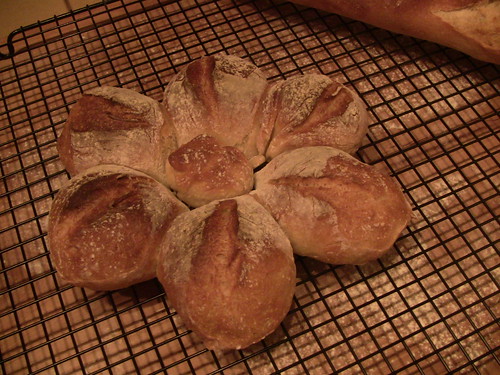
This week’s baking—and cooking-- were inspired by Fresh Loaf masters proth5, Wally, SylviaH, Hansjoakim, and AW. There was duck confit, whole wheat bread, sandwich buns, and Pat’s “Getting the Bear” baguettes (aka “Bear-Gets”), including a Margueritte-shaped thing—"Le Fleur d’Ours".
First, let me tell you about the three-day duck. After reading Hansjoakim’s blog post (http://www.thefreshloaf.com/node/21880/totally-not-bread-confit-de-canard), I tried to resist the temptation to make duck confit. I could not. I love duck, especially duck leg confit. Han’s pictures and description started to wear down my resistance. Reading Michael Ruhlman’s blog post on the subject (http://ruhlman.com/2010/09/how-to-make-duck-confit-fall-is-here-time-to-preserve-duck.html) was the capper.
So I found a six-legged duck (Chernobyl brand). Just kidding…actually I found a nice California-grown Muscovy duck and 4 extra duck legs (from a different duck…err…probably several). I cut the legs off the duck so I’d have six for confit. Friday morning, I rubbed the legs (the ducks’, not mine) with kosher salt, fresh ground pepper, crushed garlic, thyme and oregano, and put them in a zip-loc bag in the fridge for 24 hours. Meanwhile, the excess fat from the duck and legs was rendered on the stove. The legless duck was sprinkled with poultry seasoning, allspice, onion salt and garlic salt and roasted for dinner Friday (with yams and steamed snap peas…yummm!). The fat drippings from the roasted legless duck was added to the other duck fat and refrigerated.
Saturday morning, I rinsed the cured legs, patted them dry and arranged them tightly in the bottom of our old Dutch oven, I melted the chilled duck fat in the microwave and poured it over the legs. I added enough olive oil so that the legs were fully submerged. Then I heated the Dutch oven slowly on the stove until just before the oil boiled, and put it in the oven at 180 degrees F. It stayed in that oven for 12 hours, except for an hour or so when I needed the oven for the sandwich buns described below; during that hour, I put the Dutch oven on the stove on low simmer. I also made stock from the roasted duck bones.
Saturday evening, I pulled the Dutch oven out of the oven and let it cool for a couple hours, then put it in the fridge.
They say the flavor of duck confit improves if you let it sit for days or weeks. I’ m not sure this batch will last more than a couple days. It made a splendid dinner Sunday. I roasted two of the legs in a hot oven for 30 minutes, and served them over a bed of lentil ragout (French lentils, shallots, garlic, parsley, diced celery, diced carrot, duck stock and some good Syrah).
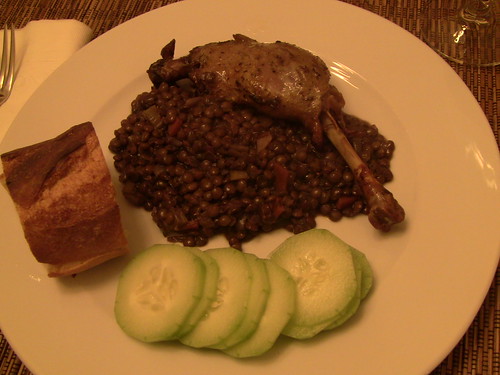
This confit recipe was not a difficult process (I skipped the stretch-and-folds with no apparent detriment to the texture), though it takes several days in elapsed time. I have to say it is totally worth the effort. The best possible preparation for a sexapedal waterfowl. And the lentil ragout (my attempt to replicate a dish served at a wonderful local bistro called Fringale) was a great success. Recipe provided on request.
Now, about the breads…starting with a 37.5% whole wheat sandwich bread.
I hadn’t made a whole wheat sandwich loaf since I was a real beginner (back last September), and it was only so-so. But my wife and I do love whole wheat bread, and I recently acquired some special whole wheat flour from Central Milling: the high-protein, fine ground organic whole wheat flour they sell to Acme Bread. I searched TFL for a recipe and found AW’s post with her friend Ben’s formula, which has become very popular on TFL (http://www.thefreshloaf.com/node/16345/whole-wheat-sandwich-bread).
I followed AW’s formula, substituting vegetable oil for shortening and a combination of honey and molasses for brown sugar. In an embarrassing lapse of baking sense, I forgot to reduce the water to compensate for the liquid sweeteners, so the bread took a while longer to bake than prescribed, and the crumb is very moist. Not gummy or unpleasant, just very moist. It is soft but holds together well when sliced. I also under-proofed the loaves and they blew out. It’s not the prettiest bread I ever baked, but the flavor is outstanding! Wheaty and molasses-y, it tastes healthy, but it’s good. It made good duck breast sandwiches.
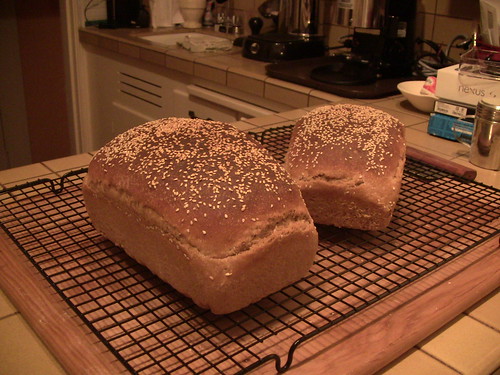
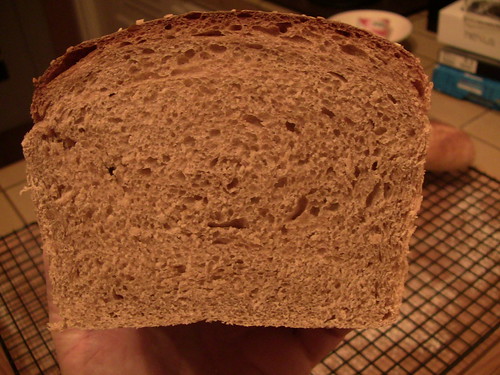
Then, about SylviaH’s buns!!
One of my great aspirations as a baker is to make good-tasting simple sandwich buns that hold up to sloppy sandwich ingredients like saucy barbecue beef. I’d tried the Italian bread rolls (http://www.thefreshloaf.com/node/12485/sourdough-italian-bread-and-sandwich-rolls) and the sourdough potato rolls (http://www.thefreshloaf.com/node/3886/sourdough-potato-bread). Both were good, but too heavy and too chewy for what I was after. Brother David suggested I try SylviaH’s highly-enriched sandwich buns (http://www.thefreshloaf.com/node/17329/buns-sandwiches). So, I did.
Having roasted a tri-tip (with Tony Cachere’s Cajun seasoning) during the week, I had a hankering for barbecue beef sandwiches. I had half of bottle of the Firehouse No. 2 barbecue sauce in the fridge, so all I needed was buns. Sylvia’s formula is easy and the results are excellent! It’s basically a challah dough with some potato, and it tastes like delicious challah. Eggy in a good way, tender crumb. It held up well under barbecue beef.

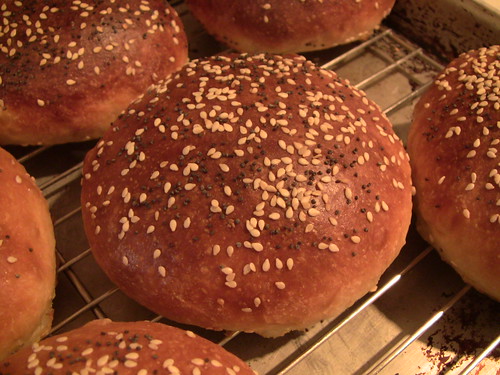


And, finally, the “Bear-Gets”.
Proth5’s baguettes are legendary for good reason. Brother David had recommended Pat’s prior formula, and I made them several times, and always loved them. I’ve baked her new “Getting the Bear” baguette formula (http://www.thefreshloaf.com/node/20831/starting-get-bear) a couple times. It may or may not be better (which is better: magnifique or merveilleux?), but it’s real dang good.
I followed the formula, using my favorite white flour, Central Milling’s Organic Artisan Baker’s Craft, enriched with malted barley flour. I made enough for four 9.5- ounce mini-baguettes and two 13-ounce Marguerittes, inspired by Larry’s recent adventures (http://www.thefreshloaf.com/node/21929/little-baguette-fun). I had to do three bakes because of the size of my stone. I baked a Margueritte and a mini-baguette Saturday evening after a 6-hour retard; then two batches Sunday morning.
The dough was incredibly airy, but easy to handle. The crumb is just about perfect. Here’s a crumb shot of a baguette followed by a piece of La Margueritte.


Making les marguerittes was fun. This is the first time I’ve scissored dough, and it was a good experience. I found the video linked in Larry’s post very helpful. Nothing difficult about it, but there’s lots of room for improvement in the snipping and shaping. The pull-away rolls from “le fleur d’ours” are delicious.

Anyway…that was a long blog post. The next one will be shorter. Tasha’s learning to write.

Glenn